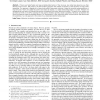23 search results - page 4 / 5 » Residue Contexts: Non-sequential Protein Structure Alignment... |
CIBCB
2005
IEEE
13 years 11 months ago
2005
IEEE
- Establishing structure-function relationships on the proteomic scale is a unique challenge faced by bioinformatics and molecular biosciences. Large protein families represent nat...
BMCBI
2007
13 years 5 months ago
2007
Background: By virtue of their shared ancestry, homologous sequences are similar in their structure and function. Consequently, multiple sequence alignments are routinely used to ...
CIKM
2009
Springer
13 years 12 months ago
2009
Springer
Background: Although both conservation and correlated mutation (CM) are important information reflecting the different sorts of context in multiple sequence alignment, most of ali...
BMCBI
2006
13 years 5 months ago
2006
Background: The residue-wise contact order (RWCO) describes the sequence separations between the residues of interest and its contacting residues in a protein sequence. It is a ne...
VIS
2007
IEEE
14 years 6 months ago
2007
IEEE
Proteins are highly flexible and large amplitude deformations of their structure, also called slow dynamics, are often decisive to their function. We present a two-level rendering ...

